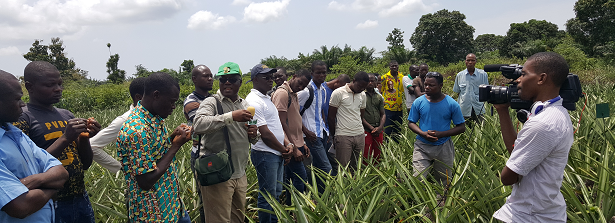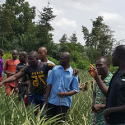Farmer’s voice matters in agronomic practices development

Pineapple is one of the most important tropical fruits in the world and represents the third crops to be promoted by Beninese government under the Government Action Plan (PAG) (2016-2021). The government aims at improving the yield and the competitiveness of fresh pineapple as well as pasteurized pineapple juice in Benin. The Applied Research Fund project “Designing appropriate agronomic and processing practices for pineapple supply chains in Benin (DAPIS)” funded by WOTRO fits very well with the PAG and aims at improving the access of fresh pineapple and pasteurised pineapple juice produced in Benin to local, regional and international markets. The project started since October 2015 and significant progress have been made so far.
Regarding agronomic practices development, four (4) experiments have been installed in pineapple production areas. On September 21, 2017, the first pineapple experiment installed at Zè (one of the main pineapple production areas in Atlantic Department in Benin Republic), has been visited by farmers and consortium members of this ARF project in Benin.
The field was at the stage of flower emergence (13 months after planting) and more than 20 farmers (about 19 male and 1 female) were present. The farmers were split in two groups and were asked to look at the different experimental units and select which one will lead to preferred fruits for market. Treatments being tested are the combination of planting density (D1: 54 400 plants/ ha, D2: 66 600 plants/ ha and D3: 74 000 plants/ha) and the amount of potash applied (E1:2.75 g K2O/plant; E2: 7.83 g K2O/plant and E3: 15.66 g K2O/plant). The treatments D1 and E1 are farmer’s practices. The farmers gave their opinion on which density would give big fresh pineapples fruit at harvesting time. Unanimously, farmers selected plot D2 as the experimental unit that will give the biggest fruits and argued that D3 will lead to the longest fruits. When farmers were asked to determine the combination of treatments (D and E) that would give high fruit weight, they could not reach a clear conclusion on whether it would be D2E2 or D2E3.
Conclusion of this visit is that involving the farmers in this experience is very important, because some researchers in the consortium hypothesized that D3 would yield biggest fruits, which was contradicted by the farmers’ conclusion. In fact, with D3, density is high and plants in the plots D3 was higher than those in other plots. So, one would expect D3 to yield biggest fruits compared to D2. Thus, beneficiaries i.e. farmer’s voice is important and should count in the co-creation approach!
Fruits from the first and second experiments installed during the long rainy season will be harvested in December and January respectively. Fruits from the first and second experiments installed during the short rainy season will be harvested in March. This means the project is close to the end of this experiment and collected data will confirm which treatment would give preferred fruits for different markets. Next, outputs dissemination will start.
Please watch the video of this visit (in French):






